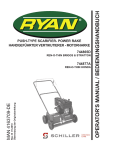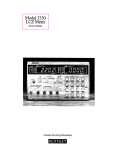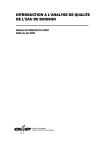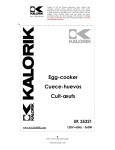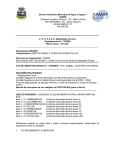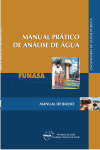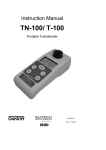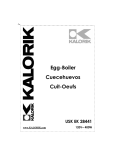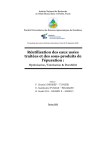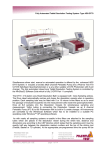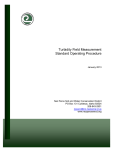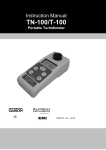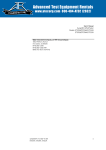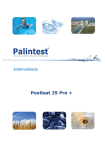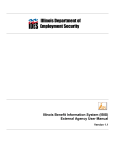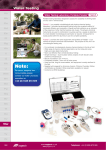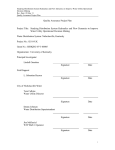Download Standard Operation Procedure - Ru
Transcript
Islamic Republic of Afghanistan Ministry of Rural Rehabilitation and Development Rural Water Supply, Sanitation and Irrigation Programme Standard Operation Procedure For Drinkign Water Quality Feberuary, 2012 Prepared by; Ru-WATSIP/MRRD Water quality Lab Staff and Abdus Saboor WQ Consultant Table of Contents Introduction of RuWATSIP/MRRD Water Quality Laboratory; ..............................................................................6 Standard Operation Procedure for detection of Bacteriological parameters; ......................................................7 PURPOSE: .............................................................................................................................................................7 SCOPE: ..................................................................................................................................................................7 Definitions: ...........................................................................................................................................................7 PRINCIPLE:............................................................................................................................................................8 RESPONSIBILITY:...................................................................................................................................................8 HEALTH AND SAFETY:...........................................................................................................................................8 INTERFERENCES....................................................................................................................................................9 MEDIA PREPARATION: .........................................................................................................................................9 PROCEDURE:...................................................................................................................................................... 10 STERILIZATION: ............................................................................................................................................. 10 Total Coliform Presumptive Test MPN Method: .......................................................................................... 10 Coliform Confirmation Test: ......................................................................................................................... 11 Escherichia Coli (E. Coli):............................................................................................................................... 11 Standard Operation Procedure for detection of pH in water; ............................................................................ 13 PURPOSE: .......................................................................................................................................................... 13 SCOPE: ............................................................................................................................................................... 13 RESPONSIBILITY:................................................................................................................................................ 13 DEFINITIONS:..................................................................................................................................................... 13 HEALTH AND SAFETY:........................................................................................................................................ 13 CAUTIONS:......................................................................................................................................................... 13 INTERFERENCES:................................................................................................................................................ 14 PROCEDURE:...................................................................................................................................................... 14 CALIBRATION PROCEDURE (Auto Buffer Recognition): ................................................................................ 14 OPERATIONAL PROCEDURE [2]: ..................................................................................................................... 14 Standard Operation Procedure for detection of Turbidity in water;.................................................................. 16 PURPOSE: .......................................................................................................................................................... 16 SCOPE: ............................................................................................................................................................... 16 PRINCIPLE:......................................................................................................................................................... 16 RESPONSIBILITY:................................................................................................................................................ 16 HEALTH AND SAFETY:........................................................................................................................................ 16 CAUTIONS:......................................................................................................................................................... 17 DILUTION:.......................................................................................................................................................... 17 PROCEDURE:...................................................................................................................................................... 18 Sample preparation: ..................................................................................................................................... 18 Calibration procedure:.................................................................................................................................. 18 OPERATIONAL PROCEDURE [2]: ..................................................................................................................... 19 Standard Operation Procedure for detection of Electical Conductivity in water; ............................................. 20 PURPOSE: .......................................................................................................................................................... 20 SCOPE: ............................................................................................................................................................... 20 PRINCIPLE:......................................................................................................................................................... 20 RESPONSIBILITY:................................................................................................................................................ 20 HEALTH AND SAFETY:........................................................................................................................................ 20 CAUTIONS:......................................................................................................................................................... 20 PROCEDURE:...................................................................................................................................................... 21 CALIBRATION PROCEDURE (Automatic Conductivity Calibration): .............................................................. 21 CALIBRATION PROCEDURE (Temperature Calibration): ............................................................................... 21 Standard Operation Procedure Manual for Analysis of Drinking water quality Page 1 of 64 OPERATIONAL PROCEDURE [2]: ..................................................................................................................... 22 Standard Operation Procedure for detection of Color in water; ........................................................................ 23 PURPOSE : ......................................................................................................................................................... 23 SCOPE: ............................................................................................................................................................... 23 RESPONSIBILITY:................................................................................................................................................ 23 DEFINITIONS:..................................................................................................................................................... 23 HEALTH AND SAFETY:........................................................................................................................................ 23 CAUTIONS:......................................................................................................................................................... 23 PRINCIPLE:......................................................................................................................................................... 24 APPLICATION:.................................................................................................................................................... 24 INTERFERENCE: ................................................................................................................................................. 24 APPARATUS: ...................................................................................................................................................... 24 PREPARATION OF STANDARDS ......................................................................................................................... 24 PROCEDURE:...................................................................................................................................................... 25 CALCULATION:................................................................................................................................................... 25 Standard Operation Procedure for detection of Arsenic in water;..................................................................... 26 PURPOSE: .......................................................................................................................................................... 26 SCOPE: ............................................................................................................................................................... 26 PRINCIPLE:......................................................................................................................................................... 26 RESPONSIBILITY:................................................................................................................................................ 26 HEALTH AND SAFETY:........................................................................................................................................ 26 CAUTIONS:......................................................................................................................................................... 26 CALIBRATION:.................................................................................................................................................... 27 Standard Arsenic solution preparation:............................................................................................................ 27 PROCEDURE:...................................................................................................................................................... 27 Loading Bung Devices:....................................................................................................................................... 27 Sample Preparation:.......................................................................................................................................... 27 Arsenic Measurement:...................................................................................................................................... 27 Standard Operation Procedure for detection of Residual Chlorine in water;.................................................... 28 PURPOSE: .......................................................................................................................................................... 28 SCOPE: ............................................................................................................................................................... 28 DEFINITIONS:..................................................................................................................................................... 28 PRINCIPLE:......................................................................................................................................................... 28 RESPONSIBILITY:................................................................................................................................................ 28 HEALTH AND SAFETY:........................................................................................................................................ 28 CAUTIONS:......................................................................................................................................................... 29 PROCEDURE:...................................................................................................................................................... 29 Standard Operation Procedure for detection of Total Iron in water;................................................................. 30 PURPOSE: .......................................................................................................................................................... 30 SCOPE: ............................................................................................................................................................... 30 RESPONSIBILITY:................................................................................................................................................ 30 Principle:............................................................................................................................................................ 30 HEALTH AND SAFETY:........................................................................................................................................ 30 CAUTIONS:......................................................................................................................................................... 30 INTERFERENCES:................................................................................................................................................ 31 APPARATUS: ...................................................................................................................................................... 31 REAGENTS AND SOLUTIONS:............................................................................................................................. 31 PROCEDURE:...................................................................................................................................................... 31 Spectrophotometric setup :.......................................................................................................................... 31 Total Iron Determination and Calibration Curve [2]: ..................................................................................... 32 Standard Operation Procedure Manual for Analysis of Drinking water quality Page 2 of 64 Standard Operation Procedure for detection of Fluoride in water; ................................................................... 33 PURPOSE: .......................................................................................................................................................... 33 SCOPE: ............................................................................................................................................................... 33 RESPONSIBILITY:................................................................................................................................................ 33 Principle:............................................................................................................................................................ 33 HEALTH AND SAFETY:........................................................................................................................................ 33 CAUTIONS:......................................................................................................................................................... 34 INTERFERENCES:................................................................................................................................................ 34 APPARATUS: ...................................................................................................................................................... 34 REAGENTS AND SOLUTIONS:............................................................................................................................. 35 PROCEDURE:...................................................................................................................................................... 35 Spectrophotometric setup :.......................................................................................................................... 35 Total Iron Determination and Calibration Curve [2]: ..................................................................................... 36 Standard Operation Procedure for detection of Chloride in water;................................................................... 37 PURPOSE : ......................................................................................................................................................... 37 SCOPE AND APPLICATION: ................................................................................................................................ 37 RESPONSIBILITY:................................................................................................................................................ 37 SUMMARY OF METHOD:................................................................................................................................... 37 HEALTH AND SAFETY WASTE HANDLING:......................................................................................................... 37 INTERFERENCES:................................................................................................................................................ 37 REAGENTS AND SOLUTIONS:............................................................................................................................. 38 PROCEDURE:...................................................................................................................................................... 38 Standardization of Silver Nitrate Titrant:...................................................................................................... 38 SAMPLE PREPARATION................................................................................................................................. 39 Calculation: ................................................................................................................................................... 40 Standard Operation Procedure for detection of Total Hardness in water; ........................................................ 41 PURPOSE : ......................................................................................................................................................... 41 SCOPE AND APPLICATION: ................................................................................................................................ 41 RESPONSIBILITY:................................................................................................................................................ 41 PRINCIPLE & SUMMARY OF METHOD:.............................................................................................................. 41 HEALTH AND SAFETY WASTE HANDLING:......................................................................................................... 41 INTERFERENCES:................................................................................................................................................ 42 TITRATION PRECAUTIONS: ................................................................................................................................ 42 REAGENTS AND SOLUTIONS:............................................................................................................................. 42 PROCEDURE:...................................................................................................................................................... 43 CALCULATION ............................................................................................................................................... 43 Standard Operation Procedure for detection of Nitrate in water; ..................................................................... 44 PURPOSE: .......................................................................................................................................................... 44 SCOPE: ............................................................................................................................................................... 44 PRINCIPLE:......................................................................................................................................................... 44 RESPONSIBILITY:................................................................................................................................................ 44 METHOD SUMMARY: ........................................................................................................................................ 44 HEALTH AND SAFETY:........................................................................................................................................ 45 INTERFERENCES:................................................................................................................................................ 45 REAGENTS: ........................................................................................................................................................ 45 PROCEDURE:...................................................................................................................................................... 46 Preparation of Calibration Curve:................................................................................................................. 46 Measurement of sample:.............................................................................................................................. 46 Standard Operation Procedure for detection of Bicarbonate & carbonate in waer;......................................... 47 PURPOSE: .......................................................................................................................................................... 47 Standard Operation Procedure Manual for Analysis of Drinking water quality Page 3 of 64 SCOPE AND APPLICATION: ................................................................................................................................ 47 RESPONSIBILITY:................................................................................................................................................ 47 PRINCIPLE & SUMMARY OF METHOD:.............................................................................................................. 47 HEALTH AND SAFETY WASTE HANDLING:......................................................................................................... 47 INTERFERENCES:................................................................................................................................................ 47 TITRATION PRECAUTIONS: ................................................................................................................................ 48 REAGENTS AND SOLUTIONS:............................................................................................................................. 48 PROCEDURE BICARBONATE: ............................................................................................................................. 48 CALCULATION: .............................................................................................................................................. 49 PROCEDURE CARBONATE: ................................................................................................................................ 49 CALCULATION: .............................................................................................................................................. 49 Standard Operation Procedure for detection of Potassium in water;................................................................ 50 Scope and application: ...................................................................................................................................... 50 Storage of samples:........................................................................................................................................... 50 Minimum detectable concentration:................................................................................................................ 50 Principle:............................................................................................................................................................ 50 Reagents:........................................................................................................................................................... 50 Operation: ......................................................................................................................................................... 51 Shutdown: ......................................................................................................................................................... 51 Operating precautions: ..................................................................................................................................... 52 Standard Operation Procedure for detection of Sodium in water; .................................................................... 53 Scope and application: ...................................................................................................................................... 53 Storage of samples:........................................................................................................................................... 53 Minimum detectable concentration:................................................................................................................ 53 Principle:............................................................................................................................................................ 53 Reagents:........................................................................................................................................................... 54 Operation: ......................................................................................................................................................... 54 Shutdown: ......................................................................................................................................................... 55 Operating precautions: ..................................................................................................................................... 55 Standard Operation Procedure for detection of Sulfate in water; ..................................................................... 56 PURPOSE: .......................................................................................................................................................... 56 SCOPE: ............................................................................................................................................................... 56 RESPONSIBILITY:................................................................................................................................................ 56 PRINCIPLE:......................................................................................................................................................... 56 HEALTH AND SAFETY:........................................................................................................................................ 56 CAUTIONS:......................................................................................................................................................... 56 INTERFERENCES:................................................................................................................................................ 57 APPARATUS: ...................................................................................................................................................... 57 REAGENTS AND SOLUTIONS:............................................................................................................................. 57 PROCEDURE:...................................................................................................................................................... 57 Spectrophotometric setup:........................................................................................................................... 57 Turbidity meter setup ....................................................................................................................................... 58 Sulfate Determination and Calibration Curve:.................................................................................................. 59 Standard Operation Procedure for detection of Cacium in water;..................................................................... 60 PURPOSE: .......................................................................................................................................................... 60 SCOPE AND APPLICATION: ................................................................................................................................ 60 RESPONSIBILITY:................................................................................................................................................ 60 PRINCIPLE & SUMMARY OF METHOD:.............................................................................................................. 60 HEALTH AND SAFETY WASTE HANDLING:......................................................................................................... 60 INTERFERENCES:................................................................................................................................................ 60 Standard Operation Procedure Manual for Analysis of Drinking water quality Page 4 of 64 TITRATION PRECAUTIONS: ................................................................................................................................ 61 REAGENTS AND SOLUTIONS:............................................................................................................................. 61 PROCEDURE:...................................................................................................................................................... 62 CALCULATION: .............................................................................................................................................. 62 References:............................................................................................................................................................ 63 Standard Operation Procedure Manual for Analysis of Drinking water quality Page 5 of 64 Introduction of RuWATSIP/MRRD Water Quality Laboratory; Afghanistan is confronted with a number of basic environmental health issues, unsafe drinking water, inadequate sanitation facilities, poor water supply, and hazardous waste water management, poor water quality like chemical contamination and Microbial contamination. Afghanistan has the highest child mortality rate every year; the main cause of death is unsafe drinking water and waterborne diseases which can be prevented, drinking water must be free from components which may adversely affect the human health. Such components include minerals, organic substances and disease causing microorganisms a large portion of the population in developing countries suffers from health problems associated with either lack of drinking water or due to the presence of microbiological contamination in water poor water quality is responsible for the death of children special under the five year old in the developing countries the problem is further aggravated by rapidly increasing population which results in poor water quality management. Rural Water Supply, Sanitation & Irrigation Program (RuWATSIP) Ministry of Rural Rehabilitation and Development (MRRD) are responsible to provide safe drinking water across the country. RuWATSIP Department with technical and financial support by UNICEF had inaugurated Water Quality Laboratory to target community and all water sources in provinces of Afghanistan and distribute safe drinking water for all. Water quality Laboratory has two parts, first one is Chemical/Physical Lab and second part is Bacteriological lab water quality Laboratory inaugurated with a formal meeting and started their activities on 18/July/2011 (27/Saratan/1390). UNICEF Kabul and RuWATSIP supplied these laboratories with necessary chemicals and Bacteriological equipment for testing of basic 29 water quality parameters. Implementing water quality program across Afghan communities will extend the strategy, policy and of water quality in providing safe drinking water for Afghan people. Standard Operation Procedure Manual for Analysis of Drinking water quality Page 6 of 64 Standard Operation Procedure for detection of Bacteriological parameters; Standard Operation Procedure (MPN Method) for Total Coliform, Fecal Coliform and Escherichia Coli Examination in Water (IS 1622-1981, Reaff: 2003) PURPOSE: To establish a procedure for determination of Coliform and E. Coli in water SCOPE: This method is used to examine coliform and E. Coli in drinking water, natural surface water, and groundwater, domestic and industrial wastewater. DEFINATIONS: Broth: A mixture of chemicals which will encourage the growth of a specific organism or group of organisms. Kovac’s Reagent: It is used to detect the presence of indole. Used in the identification of bacteria. Buffer: A chemical which has the ability or capacity to neutralize acids or bases. Coliform: A group of bacteria which can be used as an indicator of pollution. A major portion of this group live in the intestinal tract of warm blooded animals, including human beings. They are easy to identify and count in the laboratory because of their ability to ferment lactose. E. Coli: A type of bacteria belonging to the fecal coliform group of bacteria found primarily in the gut and feces of warm blooded animals. Most E. coli strains are harmless, but some can cause food poisoning in humans. Of the several types of bacteria in the total colifom group, E. coli does not typically reproduce in soil and water environments. Their ability to survive for brief periods outside the body makes them an ideal indicator organism to test environmental samples for fecal contamination. Colony: A group of bacteria growing on a supporting surface. The colony is considered to be the result of the growth and reproduction of a single cell. Disinfection: To destroy most (but not necessarily all) of the harmful or objectionable microorganisms by means of chemicals, heat, ultraviolet light, etc. Fermentation: The process by which bacteria convert organic matter into carbon dioxide and water. Fermentation Tube: A container designed to allow easy identification of gas production. Standard Operation Procedure Manual for Analysis of Drinking water quality Page 7 of 64 Fecal Coliform: A subclass of the coliform bacteria which originate almost exclusively in the intestinal tract of warm blooded animals. Inoculation: The process by which a sample or seed culture is introduced into a system. MPN: The most probable number (MPN) of coliform or fecal coliform bacteria per unit volume of a sample. It is expressed as the number of organisms which are most likely to have produced the laboratory results noted in a particular test. Medium (Media): A substance (or substances) used to provide nutrients for the growth of bacteria. Pathogenic Organisms: Bacteria, viruses, protozoa, etc. which can cause disease in animals or human beings. Sterilization: Destruction or removal of all viable or living organisms. PRINCIPLE: Fecal coliform bacteria are non-disease causing organisms which are found in the intestinal tract of all warm blooded animals. Each discharge of body wastes contains large amounts of these organisms. The presence of fecal coliform bacteria in a stream or lake indicates the presence of human or animal wastes. The number of fecal coliform bacteria present is a good indicator of the amount of pollution present in the water. RESPONSIBILITY: WQL Analyst: Operation and Calibration. WQL Manager: Receiving sample & log book entry and Implementation of this SOP. WQ Consultant: QC/QA. HEALTH AND SAFETY: Wear personal protective equipment including gloves, lab coat, and safety glasses and handle all chemicals with caution. Work under fume hood to avoid inhaling vapors. Standard Operation Procedure Manual for Analysis of Drinking water quality Page 8 of 64 Special care should be taken when working with autoclaves due to high temperature and pressures. Face shields, aprons, and temperature resistant gloves should always be worn when opening or removing items from autoclaves. Do not look directly into the UV light. INTERFERENCES Samples may contain material that affects the color of the sample. If this situation does arise, compare inoculated trays to a control tray containing only water. Test sensitivity maybe affected by taking the samples out of the incubator too soon ending with false negatives. Test samples should be incubated forthe full term. Autofluorescentplastic ware or glassware may produce false positives. Check sample containers prior to sampling and processing. MEDIA PREPARATION: Single strength MacConkey medium: Dissolve 35.0 g in 1 liter of distilled or deionized water.Stir slowly until complete dissolution.Dispense in tubes containing a Durham tube.Sterilize in an autoclave at 121°C for 15 minutes.After cooling, the Durham tubes should not contain air. Double strength MacConkey medium: Dissolve 70.0 g in 1 liter of distilled or deionized water. Stir slowly until complete dissolution. Dispense 10 mL in 20 x 200 mm tubes (without a Durham tube). Sterilize in an autoclave at 121°C for 15 minutes. Brilliant Green Bile Lactose medium: Dissolve 20.0 g in 1 liter of distilled or deionized water. Stir slowly until complete dissolution. Sterilize in an autoclave at 121°C for 15 minutes. Peptone Water: Dissolve 10.0 g peptone water and 5.0 g NaClin 1 liter of distilled or deionized water. Sterilize in an autoclave at 121°C for 15 minutes. Standard Operation Procedure Manual for Analysis of Drinking water quality Page 9 of 64 PROCEDURE: STERILIZATION: Hot Air Sterilizer: All equipment should be wrapped in high quality paper or placed in containers prior to hot air sterilization. All glassware, except those in metal containers, should be sterilized for a minimum of 60 minutes at 170°C. Sterilization of glassware in metal containers should require a minimum of 2 hours. Hot air sterilization should not be used for glassware containing media or other liquids. The caps or stoppers of glassware sterilized in a hot air sterilizer should be partially loosened to prevent pressure buildup during sterilization. Autoclave: Sample bottles, dilution water, culture media and glassware may be sterilized by autoclaving at 121°C for 15 minutes. The autoclaving process uses steam and pressure (15 psi) for sterilization. Care should be taken that the pressure has returned to zero prior to opening the autoclave to prevent injuries or loss of sterilized liquids. The caps or stoppers of glassware sterilized in an autoclave or pressure cooker should be partially loosened to prevent pressure buildup inside the containers. Total Coliform Presumptive Test MPN Method: Homogenize water sample by gentle shaking. Take 15 sterilized test tubes and divide into three sets, each set of 5. To each test tube of 1st set add 10 ml of double strength MacConkey broth. Whereas to 2nd and 3rd set of tubes add 5 of single strength MacConkey broth. To all set of tubes insert inverted Durham tubes, cap each tightly and sterilize in autoclave. After sterilization the tube are brought to room temperature. To each test tube of 1st set containing double strength media, add 10 ml water sample with sterilized pipette. To 2nd set of tubes add 1 ml sample and add0.1 ml water sample to 3rd set of test tubes. Incubate all above three set of test tubes at 37 ±1°Cfor 48 hours. After the due time examine color change and gas formation in durham tubes. Any tube with color change to yellow or gas formed in durham tubes are consider positive, note the number of positive tubes in each set and find the MPN from table-1. If no color change or gas formation is observed discontinue the test and report less than 2 coliform/100 ml. Standard Operation Procedure Manual for Analysis of Drinking water quality Page 10 of 64 Coliform Confirmation Test: In sterilized test tube insert inverted durham tube and add 10 ml of Brilliant Bile Green Lactose broth and transfer loopful from each individual positive tubes. Incubate the tubes at 37 ±1°C for 48 hours. Examine the tubes for gas formation. No gas production observed disconnect the test and report as less than 2 Coliform/100 me MPN. If gas is produced in durham tubes, record the positive tubes out of 15 tubes as confirmed for coliform and proceed for E. Coli test. Escherichia Coli (E. Coli): Inoculate loopful from each confirmed positive BGBL broth test tube to 10 ml new BGBL media with durham tube and incubate at 44.5 °C for 24 hours. Examine test tubes after 24 hours, if no gas production observed report negative E. Coli. If gas bubbles seen in durham tubes, inoculate loopful from BGLB broth to 5 ml of peptone water and incubate this peptone water test tube (without durham tube) at 44.5°C for 24 hours. After 24 hours add few drops of Kovac’s reagent to the test tubes. If pink color ring formation is observed, report E. Coli as positive, otherwise negative E. Coli. RFERENCES: APHA, 20th Ed. 9221 B. IS 1622-1981, Reaff:2003 NOTE: For the combination of positive tubes not appearing in Table 1 use the following formula: Standard Operation Procedure Manual for Analysis of Drinking water quality Page 11 of 64 Combination of positive tubes MPN Index per 10 mL 1 mL 0.1 mL 0 0 0 0 0 0 1 0 100ml Combination of positive tubes MPN Index per 100ml 10 mL 1 mL 0.1 mL 0 4 2 0 22 1 0 2 2 4 4 2 3 1 0 26 27 2 0 4 4 3 1 33 1 0 0 2 4 4 0 34 1 0 1 4 5 0 0 23 1 1 0 4 5 0 1 31 1 1 1 6 5 0 2 43 1 2 0 6 5 1 0 33 5 1 1 46 2 0 0 5 5 1 2 63 2 0 1 7 5 2 0 49 2 1 0 7 5 2 1 70 2 1 1 9 5 2 2 94 2 2 0 9 5 3 0 79 2 3 0 12 5 3 1 110 5 3 2 140 3 0 0 8 5 3 3 180 3 0 1 11 5 4 0 130 3 1 0 11 5 4 1 170 3 1 1 14 5 4 2 220 3 2 0 14 5 4 3 280 3 2 1 17 5 4 4 350 5 5 0 240 4 0 0 13 5 5 1 350 4 0 1 17 5 5 2 540 4 1 0 17 5 5 3 920 4 1 1 21 5 5 4 1,600 4 1 2 26 5 5 5 >2,400 REFRENCE TABLE-1 (MPN/100 ML) Standard Operation Procedure Manual for Analysis of Drinking water quality Page 12 of 64 Standard Operation Procedure for detection of pH in water; Procedure for Operation and Calibration of pH Meter (CyberScan 6000) PURPOSE: To establish a procedure for operation and calibration of pH meter. SCOPE: This procedure is applicable for operation and calibration of CyberScan 6000 pH meter only. RESPONSIBILITY: WQL Analyst: Operation and Calibration. WQL Manager: Receiving sample & log book entry and Implementation of this SOP. WQ Consultant: QC/QA. DEFINITIONS: A three-point calibration involves calibrating the pH meter with three different buffers of known pH and then checking the pH meter against a pH 7.00 standard buffer to confirm the calibration. Fill Solution = Acts as an electrical conductor between the reference inside the electrode and the solution under test. Wetting Cap = The cap that covers and protects the tip of the electrode. The wetting cap should stay on the tip of the electrode during periods of non-use. HEALTH AND SAFETY: Personal protective equipment including safety glasses and lab coats should be used. CAUTIONS: Do not allow fill solution to run dry. Add fill solution whenever the level falls more than 25 mm below the fill hole. Do not leave the electrode in organic solvents as the tip and body may be damaged. Keep the electrode of pH meter in 3M potassium chloride solution. Do not wipe the glass electrode bulb with any coarse material. If there are signs of growth or contamination in buffer solutions then discard the solutions and prepare fresh. Standard Operation Procedure Manual for Analysis of Drinking water quality Page 13 of 64 Buffer solution should not be used after 3 months [1]. INTERFERENCES: The electrodes can be stored for up to one week in 25 mm of pH 7.0 or pH 4.0 buffer. Never store the electrode in distilled water. For longer storage periods, remove the bulb protector, fill the wetting cap with KCl solution and push the wetting cap onto the tip of the electrode. PROCEDURE: CALIBRATION PROCEDURE (Auto Buffer Recognition): Switch on the instrument and make sure auto buffer recognition is selected in the setup screen. Touch standardize on the screen to access the standardization screen. Immerse the pH electrode and temperature probe in buffer solution from the selected buffer group and stir gently and wait for 1-2 minute for thermal equilibrium. The selected buffer group appears on the standardization screen. The screen will flash a beaker icon of the buffer solution you have selected. When the reading is stable, STABLE appears on the screen. Touch “Confirm” icon to standardize buffer. The meter will return to pH measure screen. Repeat step 8.1.4 and 8.1.5 for other two buffer standards. After calibration place the electrode in potassium chloride solution. OPERATIONAL PROCEDURE [2]: Immerse the rinsed electrode in the sample and stir gently. Touch measure to begin measuring your sample. The meter will accept the reading and display STABLE. The measure screen provides readout of the current sample measurement. Then the auto read function is active, the meter will lock onto a reading when the meter recognizes it as stable. The meter will not deviate from this reading until the measure button is touched. If the auto read mode is inactive, then the meter will continuously monitor the pH of the sample and the measure display screen will indicate any fluctuation in the sample pH. Standard Operation Procedure Manual for Analysis of Drinking water quality Page 14 of 64 After noting pH value, remove the electrode from the sample and rinse it with water (distilled / de – ionized) and place the electrode in potassium chloride solution. In case sample solution is viscous then wipe the electrode with the help water (de – ionized or distilled) and tissue paper. RFERENCES: p. 2052, USP25. Manual pH meter CyberScan 6000. RELATED DOCUMENTS: Procedure for Calibration program RELATED RECORD: A.Daily Calibration Record of pH meter. ANNEXURE: Nil. Standard Operation Procedure Manual for Analysis of Drinking water quality Page 15 of 64 Standard Operation Procedure for detection of Turbidity in water; Procedure for Operation and Calibration of TN100 Turbidity meter for Turbidity Examination PURPOSE: To establish a procedure for operation and calibration of TN 100 turbidity meter for turbidity determination of water. SCOPE: This method is applicable to drinking, surface, saline and ground water in the range of turbidity from 0 to 1000 Nephelometric Turbidity Units (NTU). The working range of this method is 1 to 1000 NTU. PRINCIPLE: Standard Methods 2130 B-The Nephelometric Method is based on a comparison of the intensity of light scattered by a sample under defined conditions with the intensity of light scattered by a standard reference suspension under the same conditions. The nephelometric instrument light source illuminates the sample and the intensity of the scattered light is measured at approximate right angles (90° + 30°) to the path of the incident light for samples. The higher the intensity of scattered light, the higher the turbidity. RESPONSIBILITY: WQL Analyst: Operation and Calibration. WQL Manager: Receiving sample & log book entry and Implementation of this SOP. WQ Consultant: QC/QA. HEALTH AND SAFETY: Wear proper protective equipment, which includes safety glasses, protective gloves, and a lab coat when working in the active laboratory area. Work under a fume hood and/or in an adequate ventilated area to avoid inhaling vapors, dust, etc. Standard Operation Procedure Manual for Analysis of Drinking water quality Page 16 of 64 Formazin polymer suspensions may be used as reference standards. Formazin contains hydrazine sulfate, which is a known carcinogen. Take care in handling and disposal to avoid inhalation, skin contact and ingestion. After analysis, discard analyzed samples down the drain. Retain the unused sample until the sample has been reviewed and reported. CAUTIONS: NEVER pour liquid directly into the sample well of the instrument. Always use a vial. The instrument will only accurately measure the turbidity of a sample when vials sealed with the black caps are used. The black cap serves as both seal and a light shield. Air or other trapped gases should be removed before measurement. DILUTION: This dilution procedure is necessary only when your turbidity measurement is above 1000 NTU. To measure the turbidity above 1000 NTU, dilute the sample with turbidityfree water. Turbidity-free water can be obtained by filtering deionized water through a < 0.2μm filter membrane with precision-sized pores. Measure the volume of the sample before dilution and record the value in ml (Vs). Take a known volume (Vd) of dilution water and add it to the sample. Pour 10 ml of the diluted sample in a clean vial and measure the turbidity of the diluted sample. Record this value in NTU (Td). Calculate the true turbidity (T) of the original sample - in NTU - using the following formula: T = Td * (Vs + Vd) / Vs Example: Dilute 20 ml of the original sample (whose turbidity is above 1000NTU) with 50 ml of dilution water. Measure the turbidity of the diluted sample. Ff the reading is 300 NTU, the turbidity of the original sample is 1050 NTU. (In this case: Td=300NTU, Vs=20ml, Vd=50ml, so T = 300 * (20+50) / 20 = 300*70/20 = 21000/20 = 1050). Standard Operation Procedure Manual for Analysis of Drinking water quality Page 17 of 64 PROCEDURE: Sample preparation: Obtain a clean and dry sample vial Take care to handle the sample vial by the top. Rinse the vial with approximately 10 ml of the sample water, capping the vial with the black screw cap and gently inverting it several times. Discard the used sample and repeat the rinsing procedure two more times. Fill the rinsed vial with the remaining portion (approximately 10 ml) of the grab sample up to the mark indicated in the vial. Cap the vial with the supplied black screw cap. Wipe the vial with the soft, lint-free cloth supplied. Ensure that the outside of the vial is dry, clean and free from smudges. Wipe with a soft cloth to obtain an even distribution over the entire vial’s surface. Calibration procedure: Place TN-100/ T-100 turbidity meter on a flat and level surface. Insert the CAL 1 standard (800 NTU) into the sample well, aligning the mark on the vial with the mark on the meter. Press down vial until it snaps fully into the instrument. Cover the vial using the light shield cap. Press ON/OFF key to switch the on the meter. The meter goes to measurement mode after the power-up sequence. Select the calibration function of the instrument by pressing the CAL key once. The “CAL” annunciator blinks momentarily and the meter prompt for the first calibration standard “CAL 1 800 NTU”. Press READ/ENTER key. The “CAL 1 800 NTU” annunciator blinks for about 12 seconds while the instrument performs calibration of CAL 1 point. When the instrument has completed calibration for this point, it prompts you to insert the next calibration standard into the sample well “CAL 2 100 NTU”. Repeat the calibration for CAL 2, CAL 3 & CAL 4 calibration standards. After you successfully calibrate the CAL 4 standard (0.02 NTU), the display shows “STbY”. Page 18 of 64 Standard Operation Procedure Manual for Analysis of Drinking water quality The meter is now ready for measurement. Figure 5 shows the complete calibration sequence OPERATIONAL PROCEDURE [2]: Place TN-100/ T-100 turbidity meter on a flat and level surface. Place the sample vial inside the sample well and align the vial’s index mark with the meter’s index mark. Push the vial until it is fully snapped in. Cover the vial with the light shield cap. Turn on the meter by pressing the ON/OFF key. After the power-up sequence, the meter goes to measurement mode and the display blinks “-Rd--“ for about 10 times. The measured reading appears in the display. If necessary, place the second sample vial into the sample well. Remember to align the vial’s mark with the meter’s index mark. Press READ/ENTER key. The display blinks “--Rd--“ for several times and measured reading appears. Repeat steps 2 through 9 for all other samples. RFERENCES: p. 2-44, APHA, 20th Ed. Instruction Manual TN-100/ T-100 RELATED DOCUMENTS: Procedure for Calibration program RELATED RECORD: Daily Calibration Record of Turbidity meter. ANNEXURE: Nil. Standard Operation Procedure Manual for Analysis of Drinking water quality Page 19 of 64 Standard Operation Procedure for detection of Electical Conductivity in water; Procedure for Operation and Calibration of CON 510 Conductivity meter for Electrical Conductivity Examination PURPOSE: To establish a procedure for operation and calibration of CON 510 Conductivity meter for electrical conductivity determination of water SCOPE: This procedure is applicable for operation and calibration of CON 510 Conductivity meter only. PRINCIPLE: The measurement of electrical conductivity (EC) in water results from ions in solution from dissolved salts. Measurement of conductivity gives an estimate of the concentration of these dissolved salts. Conductivity of an aqueous solution is the measure of its ability to carry an electric current by means of ionic motion. This ability depends on the concentration, mobility and valence ions present in solution and on the temperature of measurement. RESPONSIBILITY: WQL Analyst: Operation and Calibration. WQL Manager: Receiving sample & log book entry and Implementation of this SOP. WQ Consultant: QC/QA. HEALTH AND SAFETY: Personal protective equipment including safety glasses and lab coats should be used. CAUTIONS: Protect the conductivity standard solution from air, because of the absorption of atmospheric CO2 which may change the conductivity [1]. Always rinse the probe with de-ionized or distilled water before use and after each sample to remove any impurities adhering to the probe body. Shake or air dry. To avoid contamination or dilution of sample, rinse probe with a small volume of your sample solution. Standard Operation Procedure Manual for Analysis of Drinking water quality Page 20 of 64 PROCEDURE: CALIBRATION PROCEDURE (Automatic Conductivity Calibration): Turn on the instrument and select conductivity mode by pressing MODE key. Rinse the probe thoroughly with de-ionized water, and then rinse with a small amount of calibration standard. Dip the probe into the calibration standard. Immerse the probe tip beyond the upper steel band. Stir the probe gently to create a homogenous sample. Allow time for the reading to stabilized Press CAL/MEAS to enter conductivity calibration mode. The [CAL] indicator will appear in the upper right corner of the display. The lower display will scan and locked the closest set calibration value momentarily. Pressing before the set displayed value being locked will be prompted by an error message and remain in the calibration mode. Wait for [READY] indicator to appear before pressing ENTER key to confirm calibration value. The upper display will show "dOnE" once the calibration is successfully performed. To abort calibration without confirming, press CAL/MEAS to revert back to measurement mode. No calibration is performed at this stage. To perform the next point calibration in the multi-point calibration repeat step 1-7 again until all points have been calibrated if necessary. CALIBRATION PROCEDURE (Temperature Calibration): Make sure the electrode is properly connected. Turn on the meter. The ATC indicator will appear at the right hand side of the LCD to indicate that the temperature sensor is in good working condition. If the ATC indicator does not light up, see SETUP sub-menu P3.3 to switch it on. Press MODE key to select either conductivity or TDS mode. Press CAL/MEAS to enter either Conductivity or TDS calibration mode. The [CAL] indicator appears above upper display. While you are in conductivity or TDS calibration mode press MODE to enter into Temperature calibration mode. The upper display show the current temperature reading and the lower display shows the factory default temperature value. Standard Operation Procedure Manual for Analysis of Drinking water quality Page 21 of 64 Dip the ATC electrode into a solution of known temperature (i.e a constant temperature bath). Allow about 3-5 minutes for the built-in temperature sensor to stabilize its measured reading. Adjust using the MI/ or MR/ key to set to the correct temperature value (i.e the temperature of the bath) in increments of 0.1 °C. Maximum allowable offset temperature value is 5.0 °C. Once you have selected the correct temperature, press ENTER key. To abort or exit this calibration mode without confirming of the temperature calibration value, DO NOT press ENTER key. Press CA/MEAS key instead and the meter automatically reverts back to the measurement mode. OPERATIONAL PROCEDURE [2]: Press ON to switch on the meter and the [MEAS] in indicator appear on the top of LCD. Dip probe into the sample. Ensure that the solution level is above its upper steel band. Stir the probe gently in the sample to create a homogenous sample. Allow time for the reading to stabilize. Note the reading on the display. Press MODE to toggle between conductivity and TDS measurement. After noting EC value, remove the electrode from the sample and rinse it with water (distilled / de – ionized). In case sample solution is viscous then wipe the electrode with the help water (de – ionized or distilled) and tissue paper. RFERENCES: p. 2-44, APHA, 20th Ed. Instruction Manual CON 510 RELATED DOCUMENTS: Procedure for Calibration program RELATED RECORD: B.Daily Calibration Record of EC meter. ANNEXURE: Nil. Standard Operation Procedure Manual for Analysis of Drinking water quality Page 22 of 64 Standard Operation Procedure for detection of Color in water; Procedure for Operation and Calibration for Color Determination of Water by Visual Comparison Method PURPOSE: To establish a procedure for examination of true (not apparent) color of water. SCOPE: This procedure is applicable for determination of true color of water only. RESPONSIBILITY: WQL Analyst: Operation and Calibration. WQL Manager: Receiving sample & log book entry and Implementation of this SOP. WQ Consultant: QC/QA. DEFINITIONS: Apparent color is the color of the whole water sample, and consists of color from both dissolved and suspended components. True color is measured after filtering the water sample to remove all suspended material. The term color is used here to mean true color. HEALTH AND SAFETY: Personal protective equipment including safety glasses and lab coats should be used. CAUTIONS: Pretreatment for Turbidity Removal: To determine color, turbidity must be removed before analysis. Methods for removing turbidity without removing color vary. Filtration yields results that are reproducible from day to day and among laboratories. However, some filtration procedures also may remove some true color. Centrifugation avoids interaction of color with filter materials, but results vary with the sample nature and size and speed of the centrifuge. When sample dilution is necessary, whether it precedes or follows turbidity removal, it can alter the measured color. Acceptable pretreatment procedures are included with each method. State the pretreatment method when reporting results. [1]. Standard Operation Procedure Manual for Analysis of Drinking water quality Page 23 of 64 PRINCIPLE: Color is determined by visual comparison of the sample with known concentrations of colored solutions. The unit of color being that produced by 1 mg platinum/L in the form of the chloroplatinate ion. APPLICATION: The platinum-cobalt method is useful for measuring color of potable water and of water in which color is due to naturally occurring materials. It is not applicable to most highly colored industrial wastewaters. INTERFERENCE: Even a slight turbidity causes the apparent color to be noticeably higher than the true color; therefore centrifuge for 1 h unless it has been demonstrated that centrifugation under other conditions accomplishes satisfactory turbidity removal. The color value of water is extremely pH-dependent and invariably increases as the pH of the water is raised. APPARATUS: Nessler tubes, matched, 50-mL, tall form. pH meter, for determining sample pH. PREPARATION OF STANDARDS Dissolve 1.246 g potassium chloroplatinate, K2PtCl6 (equivalent to 500 mg metallic Pt) and 1.00 g crystallized cobaltous chloride, CoCl2×6H2O (equivalent to about 250 mg metallic Co) in distilled water with 100 mL conc HCl and dilute to 1000 mL with distilled water. This stock standard has a color of 500 units. Prepare standards having colors of 5, 10, 15, 20, 25, 30, 35, 40, 45, 50, 60, and 70 by diluting 0.5, 1.0, 1.5, 2.0, 2.5, 3.0, 3.5, 4.0, 4.5, 5.0, 6.0, and 7.0 mL stock color standard with distilled water to 50 mL in nessler tubes. Protect these standards against evaporation and contamination when not in use. Standard Operation Procedure Manual for Analysis of Drinking water quality Page 24 of 64 PROCEDURE: Pour sample in a Nessler tube up to 50 mL mark. Similarly fill three to four tubes with colour standards which appear to correspond to the colour of the sample. Compare colour of the sample with that of the standards by viewing vertically downwards while the tubes are placed on a white surface. Use a colour comparator stand if available. If the sample colour exceeds 70 units, dilute sample with distilled water in known proportions. In case sample contains turbidity report result as apparent colour. Measure pH of each sample. CALCULATION: Calculate color unit by following equation: Color Units = A x 50/B where: A = estimated color of a diluted sample B = mL sample taken for dilution. Report color results in whole numbers and record as follows: Color Units Record to Nearest 1-50 1 51-100 5 101-250 10 251-500 20 Report sample pH. RFERENCES: APHA. 20th Ed.1998. p 2-1 -2-3 KNIGHT, A.G. 1951. The photometric estimation of color in turbid waters. J. Inst. Water Eng. 5:623. ANNEXURE: Nil. Standard Operation Procedure Manual for Analysis of Drinking water quality Page 25 of 64 Standard Operation Procedure for detection of Arsenic in water; Procedure for Operation and Calibration of Wag-WE10500 Arsenator for Arsenic Determination in Water PURPOSE: To establish a procedure for operation and calibration of Wag-WE 10500 arsenator for the determination of arsenic in clean water matrix. SCOPE: This method is applicable to (clean water matrix) i.e. drinking, surface, saline and ground water in the range of arsenic contents from 10 ppb to 500 ppb. PRINCIPLE: Water sample is treated with reagents provided with Wag-WE10500 Arsenator for 20 minutes and the gas produced during reaction changes color of the strip placed in cap of reaction bottle. The color change of strip is then visually compared with chart having arsenic ranges. RESPONSIBILITY: WQL Analyst: Operation and Calibration. WQL Manager: Receiving sample & log book entry and Implementation of this SOP. WQ Consultant: QC/QA HEALTH AND SAFETY: Wear proper protective equipment, which includes safety glasses, protective gloves, and a lab coat when working in the active laboratory area. Work under a fume hood and/or in an adequate ventilated area to avoid inhaling vapors, dust, etc. After analysis, discard analyzed samples down the drain. Retain the unused sample until the sample has been reviewed and reported. CAUTIONS: NEVER open the reaction flask during the reaction time. Ensure tight fitting of tri-filter arsenic trap bung. Standard Operation Procedure Manual for Analysis of Drinking water quality Page 26 of 64 CALIBRATION: Standard Arsenic solution preparation: Prepare arsenic standard of 10 ppb, 50 ppb and 100 ppb by taking 1ml, 5ml and 10ml from arsenic stock solution (1000 ppb) into 100ml volumetric flask and fill up to mark with distilled water. Check the arsenic 10ppb, 50ppb and 100ppb standards as described in (8.0 PROCEDURE) PROCEDURE: Loading Bung Devices: Take one hydrogen sulfide removal filter and insert into the bottom end of the bung. Take red filter slid and put one filter paper from red labeled pot, ensuring the filter paper is evenly covering the hole and close the slid holder. Get bung and insert the red filter slide into the top slot. Take black arsenic filter slid put one filter paper from black labeled pot and insert black filter slid into lower slot. Sample Preparation: Take flask and fill to the 50 ml mark with sample water. Take A1 powder sachet and pour into the flask. Drop A2 tablet carefully into the flask. Reaction will start. Immediately push down the bung device firmly into the flask. Wait for 20 minutes. After reaction time remove the black filer slid and proceed to next step Arsenic Measurement: Record corresponding color, match from color chart to obtain result in ppb (µg/l). If test result reads above 500 ppb, dilute the water sample with distilled water and repeat the process from 8.1-8.3. RFERENCES: Wag-WE10500 arsenator operation manual. ANNEXURE: Nil. Standard Operation Procedure Manual for Analysis of Drinking water quality Page 27 of 64 Standard Operation Procedure for detection of Residual Chlorine in water; Procedure for Examination of Residual Chlorine in Water by Pool Tester PURPOSE: To establish a standard operation procedure for residual chlorine determination in water. SCOPE: This method is for the analysis of residual chlorine in drinking water. DEFINITIONS: When chlorine is dissolved in clear water in sufficient quantities, will destroy most disease causing organisms without being a danger to people. The chlorine, however, is used up as organisms are destroyed. If enough chlorine is added, there will be some left in the water after all the organisms have been destroyed, this is called Free Chlorine. Free chlorine will remain in the water until it is either lost to the outside world or used up destroying new contamination. We call this measuring the Chlorine Residual. PRINCIPLE: The color comparator uses DPD-1 (N,N diethyl-p-phenylene diamine) tablets that causes a color change to pink in the presence of chlorine. RESPONSIBILITY: WQL Analyst: Operation and Calibration. WQL Manager: Receiving sample & log book entry and Implementation of this SOP. WQ Consultant: QC/QA. HEALTH AND SAFETY: Wear proper protective equipment, which includes safety glasses, protective gloves, and a lab coat when working in the active laboratory area. Work under a fume hood and/or in an adequate ventilated area to avoid inhaling vapors, dust, etc. Standard Operation Procedure Manual for Analysis of Drinking water quality Page 28 of 64 After analysis, discard analyzed samples down the drain. Retain the unused sample until the sample has been reviewed and reported. CAUTIONS: All forms of chlorine are harmful to health. Avoid skin contact and do not inhale the fumes. Chlorine should always be stored in cool, dark, dry and sealed containers and out of reach of children. The toxicity or carcinogenicity of each reagent used in this method has not been precisely identified; each chemical compound should be treated as a potential health hazard, and exposure to these chemicals should be minimized. PROCEDURE: Place one tablet in the test chamber and add a few drops of the chlorinated water supply under test. Crush the tablet, then fill chamber with the chlorinated water supply under test. Place more of the same water supply under test (without a tablet) in the second chamber. This is the blank control for colour comparison. The level of residual chlorine (R) in mg of chlorine per liter of water (mg/l) is determined by comparing the colour of the water supply under test in chamber with the tablet added with the standard colours on the vessel chamber. RFERENCES: p. 5-53-65, APHA, 20th Ed. Technical Note No. 11, WHO, 7.1.05 ANNEXURE: Nil. Standard Operation Procedure Manual for Analysis of Drinking water quality Page 29 of 64 Standard Operation Procedure for detection of Total Iron in water; Procedure for Operation and Calibration of T60 V Spectrophotometer for Total Iron Examination. PURPOSE: To establish a procedure for operation and calibration of T60 V spectrophotometer for iron determination in water. SCOPE: This procedure is applicable for operation and calibration of T60 V spectrophotometer only for total iron examination. RESPONSIBILITY: WQL Analyst: Operation and Calibration. WQL Manager: Receiving sample & log book entry and Implementation of this SOP. WQ Consultant: QC/QA. Principle: The amount of iron present in a sample is determined by first reacting the iron with 1,10phenanthroline to form a colored complex and then measuring the amount of light absorbed by this complex. Beer´s law can then be used to determine the concentration relative to absorption: A= εbc. HEALTH AND SAFETY: Personal protective equipment including safety glasses and lab coats should be used. CAUTIONS: Protect the iron standard solution from air [1]. Always rinse cuvette with distilled water before use and after each sample to remove any impurities adhering to the cuvette body. Shake or air dry. To avoid contamination or dilution of sample, rinse cuvette with a small volume of your sample solution. Do not wipe the glass cuvette with any coarse material. Standard Operation Procedure Manual for Analysis of Drinking water quality Page 30 of 64 INTERFERENCES: Among the interfering substances are strong oxidizing agents, nitrite, phosphate and chromium in concentration exceeding 10 times that of iron, cobalt and copper excess of 5 mg/L and Nickel in excess of 2 mg/L precipitate phenanthroline. APPARATUS: Spectrophotometer, for use at 510nm, providing a light path of 1cm or longer. Acid-washed glassware: use conc. HCl for cleaning all the glassware, rinse with distilled water before use. REAGENTS AND SOLUTIONS: Ammonium acetate buffer solution; Dissolve 250g NH4C2H3O2 in 150 mL water, add 700 mL glacial acetic acid. Since ammonium acetate may contain a significant amount of iron, prepare new reference standards with each buffer preparation. Phenanthroline solution; dissolve 100mg 1,10-Phenanthroline monohydrate,C12H8N2.H2O, in 100 mL water by stirring and heating to 80°C, without boiling, discard if darkens or add 2 drops conc. HCl to avoid heating. Stock iron solution (200 mg/L); slowly add 20 mL conc H2SO4 to 50 mL water and dissolve 1.404g ferrous ammonium sulphate, Fe(NH4)2(SO4)2.6H2O; add 0.1N KMnO4 dropwise until a faint pink colour persists, dilute to 1 L with water and mix. Use stock solution for further standards iron solution preparation using dilution formula. C1V1=C2V2, C1=concentration of stock, C2=concentration of required dilution standard and V1=volume of stock solution, V2=volume of the dilution standard. Prepare iron standards of 0.1. 0.2, 0.3, 0.4 and 0.5 mg/l concentration. PROCEDURE: Spectrophotometric setup: Switch on the instrument and wait for initialization process. Select Quantitation tab in work place. Select parameter setting under measure menu. There are 5 tabs; Measurement, Calibration curve, Instrument, Accessories and Quality control. Standard Operation Procedure Manual for Analysis of Drinking water quality Page 31 of 64 Measurement tab: Select single wavelength and edit 510 in the Mean wave length box. Select identifier sample and standard number. In other select duplicate to achieve more accurate data and edit 3 to have every measurement repeated 3 times. Calibration Curve: Select Abs=f(Conc) in the curve equation box. As per principle of the phenanthroline method we will have straight line equation therefore select equation order 1st. Select ppm or mg/l in the concentration unit box. Select zero interception. In curve evaluation box select R2 to have correlation coefficient. Select concentration method in the calibration method menu. Instrument: in this tab we can interchange D2 lam and W lamp but T60 V spectrophotometer has only W lamp therefore we have to change nothing. Accessories: Select 8 cell holder and click cell number of cell type icon to select the active cell position. Quantitative measurement window: It has 4 parts standards measurement table, unknown sample measurement table, calibration curve and performance. Total Iron Determination and Calibration Curve [2]: Sample preparation: Take 20 ml iron sample add 4 ml buffer and 0.8 ml phenanthroline solution and take absorption after 15 minutes reaction time at 510 nm wavelength as described above. pH of the sample should be 2.9-3.5. .After taking reading of all standards check the curve and R2 value, R2 value must be > 0.98. Once calibration cure is produced with satisfactory R2 value, click in the unknown sample table and prepare the unknown sample as described in section10.2.1. RFERENCES: p. 3-76-78, APHA 20th Ed. UVWIN 5.0 instruction manual. ANNEXURE: Nil. Standard Operation Procedure Manual for Analysis of Drinking water quality Page 32 of 64 Standard Operation Procedure for detection of Fluoride in water; Procedure for Operation and Calibration of T60 V Spectrophotometer for Fluoride Determination by SPANDS Method PURPOSE: To establish a procedure for operation and calibration of T60 V spectrophotometer for fluoride examination in water by SPANDS method. SCOPE: This procedure is applicable for operation and calibration of T60 V spectrophotometer for fluoride examination only. This method is applicable to the measurement of fluoride in drinking, surface and saline waters, domestic and industrial wastes. The method covers the range from 0.1 to about 1.4 mg/L F. RESPONSIBILITY: WQL Analyst: Operation and Calibration. WQL Manager: Receiving sample & log book entry and Implementation of this SOP. WQ Consultant: QC/QA. Principle: This method relies on the fact that when fluoride reacts with certain zirconium dyes, a colorless complex anion and a dye are formed. The complex, which is proportional to the fluoride concentration, tends to bleach the dye which therefore becomes progressively lighter as the fluoride concentration increases. In the case of the fluoride ion reaction with Zr-SPADNS (sodium 2-(parasulphophenylazo-)-1,8dihydroxy-3,6-naphthalene disulphonate), the resulting coloured complex is measured in a spectrophotometer at 570 nm. HEALTH AND SAFETY: Personal protective equipment including safety glasses and lab coats should be used. Standard Operation Procedure Manual for Analysis of Drinking water quality Page 33 of 64 CAUTIONS: The addition of the highly colored SPADNS reagent must be done with utmost accuracy because the fluoride concentration is measured as a difference of absorbance in the blank and the sample. A small error in reagent addition is the most prominent source of error in this test [1] . Care must be taken to avoid overheating the flask above the level of the solution. This is done by maintaining an even flame entirely under the boiling flask. Always rinse cuvette with distilled water before use and after each sample to remove any impurities adhering to the cuvette body. Shake or air dry. To avoid contamination or dilution of sample, rinse cuvette with a small volume of your sample solution. Do not wipe the glass cuvette with any coarse material. SPADNS Reagent is toxic and corrosive. Use care while handling the reagent. INTERFERENCES: Concentration of substances causing 0.1mg/L error at 1.0mg F-/L in SPANDS method. (+) overestimation, (-) underestimation of actual Fluoride concentration. Substance Conc. mg/L Type of error Alkalinity 5000 (-) Al3+ 0.1 (-) Cl- 7000 (+) Fe2+ 10 (-) SO42- 200 (-) Distillation is necessary for samples containing high concentration of dissolved solids. The dissolved solids interfere with the fluoride analysis. Alkalinity, aluminum, iron and sulfates have negative effect on the results while chloride and phosphate has positive effect. APPARATUS: Spectrophotometer, for use at 570nm, providing a light path of 1cm. Acid-washed glassware: use conc. HCl for cleaning all the glassware, rinse with distilled water before use. Standard Operation Procedure Manual for Analysis of Drinking water quality Page 34 of 64 REAGENTS AND SOLUTIONS: Stock fluoride solution: Dissolve 221.0mg anhydrous sodium fluoride, NaF, in distilled water and dilute to 1000 mL = 100 mg/l fluoride. Standard fluoride solution: Dilute 100 mL stock fluoride solution to 1000 mL with distilled water = 10 mg/l of fluoride. Similarly prepare 0.5, 1.0, 1.5 and 2.0 mg/l of F-. SPADNS solution: Dissolve 958mg SPADNS, sodium 2 - (parasulphophenylazo)-1,8 -dihydroxy-3,6naphthalenedisulphonate, in distilled water and dilute to 500 mL; protect from light - stable for 1 year. Zirconyl-acid reagent: Dissolve 133mg zirconyl chloride octahydrate, ZrOCl2.8H2O, in about 25 mL distilled water, add 350 mL conc HCl and dilute to 500 ml. Mixed acid zirconyl-SPADNS reagent: Mix equal volumes of SPADNS solution and zirconyl-acid reagent - stable for 2 years. Reference solution: Add 10 mL SPADNS solution to 100 mL distilled water. Dilute 7 mL conc HCl to 10 mL with distilled water and add to SPADNS solution - stable for 1 year. Set the instrument to zero with this solution. PROCEDURE: Spectrophotometric setup : Switch on the instrument and wait for initialization process. Select Quantitation tab in work place. Select parameter setting under measure menu. There are 5 tabs; Measurement, Calibration curve, Instrument, Accessories and Quality control. Measurement tab: Select single wavelength and edit 570 in the Mean wave length box. Select identifier sample and standard number. In other select duplicate to achieve more accurate data and edit 3 to have every measurement repeated 3 times. Calibration Curve: Select Abs=f(Conc) in the curve equation box. As per principle of the phenanthroline method we will have straight line equation therefore select equation order 1st. Select ppm or mg/l in the concentration unit box. Select zero interception. In curve evaluation box select R2 to have correlation coefficient. Select concentration method in the calibration method menu. Standard Operation Procedure Manual for Analysis of Drinking water quality Page 35 of 64 Instrument: in this tab we can interchange D2 lam and W lamp but T60 V spectrophotometer has only W lamp therefore we have to change nothing. Accessories: Select 8 cell holder and click cell number of cell type icon to select the active cell position. Quantitative measurement window: It has 4 parts standards measurement table, unknown sample measurement table, calibration curve and performance. Total Iron Determination and Calibration Curve [2]: Sample preparation: Pipette 10.00 mL of mixed acid-zirconyl-SPADNS reagent to each standard and mix well. Avoid contamination. Set photometer to zero absorbance with the reference solution and obtain absorbance readings of standards (at 570nm). Plot a curve of mg F- versus absorbance. Prepare a new standard curve whenever a fresh reagent or a different standard temperature is used. After taking reading of all standards check the curve and R2 value, R2 value must be > 0.98. Once we calibration cure is produced and have satisfactory R2 value, click in the unknown sample table and prepare the unknown sample as described in section10.2.1. RFERENCES: p. 4-79-86, APHA 20th Ed. UVWIN 5.0 instruction manual. ANNEXURE: Nil. Standard Operation Procedure Manual for Analysis of Drinking water quality Page 36 of 64 Standard Operation Procedure for detection of Chloride in water; Standard Procedure for Chloride Analysis in Water by the Argentometric Method 4500 Cl B, APHA PURPOSE : To establish a procedure for chloride determination in water. SCOPE AND APPLICATION: This method is based on Standard Methods 4500 Cl B APHA, 20th Ed, 1998) and is applicable to ground, drinking, surface, and saline waters, domestic and industrial wastes. The method is suitable for use in relatively clear waters when 0.15 to 10 mg Cl are present in the portion titrated. RESPONSIBILITY: WQL Analyst: Operation and Calibration. WQL Manager: Receiving sample & log book entry and Implementation of this SOP. WQ Consultant: QC/QAWQL Analyst: Operation and Calibration. SUMMARY OF METHOD: In a neutral or slightly alkaline solution, potassium chromate can indicate the end point of the silver nitrate titration of chloride. Silver chloride is precipitated quantitatively before red silver chromate is formed. HEALTH AND SAFETY WASTE HANDLING: Wear personal protective equipment (PPE) including lab coat, safety glasses, and gloves when performing chloride analysis. After analysis discard analyzed samples down the drain. Retain unused sample until the sample has been reviewed and reported. INTERFERENCES: Substances in amounts normally found in potable waters will not interfere. Bromide, iodide and cyanide register as equivalent chloride concentrations. Sulfide, thiosulfate, and sulfite ions interfere but can be removed by treatment with hydrogen peroxide. If sulfide, sulfite or thiosulfate is known to be present, add 0.5 ml H2O2 and stir for 1minute prior to titration. Standard Operation Procedure Manual for Analysis of Drinking water quality Page 37 of 64 Orthophosphate in excess of 25 mg/L interferes by precipitating as silver phosphate. Iron in excess of 10 mg/L interferes by masking the end point. In general, if color is present in the sample, it will mask the end point. Aluminum Hydroxide Al(OH)3 is used for pretreatment of highly colored samples. REAGENTS AND SOLUTIONS: 1N Sulfuric Acid – Cautiously add 28.0 ml concentrated sulfuric acid to approximately 500 ml deionized water in a 1000 ml volumetric flask and mix. Dilute to 1 L with deionized water. Mix thoroughly. Prepare on an annual basis or more often, as needed. 0.01N Sulfuric Acid – Mix 10 ml of 1N sulfuric acid with deionized water and dilute to 1 L. Store on lab shelf. Prepare on an annual basis or more often, as needed. This solution is used to adjust the pH of the water sample to between 7 and 10 pH units. 0.01N Sodium Hydroxide – Cautiously dissolve 0.4 g sodium hydroxide pellets in approximately 500 ml of deionized water and dilute to 1 L with deionized water. Store in a polyethylene bottle with a polyethylene screw cap on the lab shelf. This solution is used to adjust the pH of the water sample to between 7 and 10 pH units. Prepare on a semiannual basis or more often as needed. Sodium Chloride (NaCl) Standard (0.0141N) – Dissolve 824.0 mg NaCl (dried at 140 oC) in distilled water and dilute to 1000 mL; Chloride = 500 mg/l. Potassium chromate indicator solution: Dissolve 50 g K2CrO4 in a little distilled water. Add AgNO3 solution until a definite red precipitate is formed. Let stand 12 h, filter, and dilute to 1000 ml with distilled water. Standard silver nitrate titrant, 0.0141M (0.0141N): Dissolve 2.395 g AgNO3 in distilled water and dilute to 1000 mL; 1 mL = 500 μg Cl-. Store in brown bottle.1.00 ml = 500 mg Cl /L. Store in an amber bottle. PROCEDURE: Standardization of Silver Nitrate Titrant: Set up titration apparatus. Fill the burette to the 0.0 mark with the 0.0141N silver nitrate titrant. Transfer 20 ml of the blank into a 50 ml beaker. Standard Operation Procedure Manual for Analysis of Drinking water quality Page 38 of 64 Read the pH of the blank. Adjust the pH of the blank, as necessary, to a pH between 7-10 with 0.01N sulfuric acid or 0.01N sodium hydroxide. Add 1.0 ml potassium chromate (K2CrO4) indicator solution. Mix on the stir plate. Titrate with standard silver nitrate (AgNO3) titrant to a pinkish yellow end point and record ml of titrant used on the chloride. Be consistent in endpoint recognition. A consistent choice of endpoint is critical. Use the standard solution endpoints as a reference and always titrate to the same point to achieve reproducibility from sample to sample. Note: A blank of 0.2 to 0.3 ml is usual. Measure the pH of the Std. NaCl sample and adjust if necessary, to a pH between 7-10 with 0.01N sulfuric acid or 0.01N sodium hydroxide. Add 1.0 ml potassium chromate (K2CrO4) indicator solution. Mix on the stir plate. Titrate with standard silver nitrate titrant to a pinkish yellow end point. Be consistent in end point recognition and record ml of titrant. 1ml of AgNO3 is equal to 500 mg of chloride. Factor of standardization is calculated as; Factor =F= theoretical reading/actual reading SAMPLE PREPARATION Allow samples to come to room temperature prior to analysis. Shake the sample bottle for approximately five (5) seconds to ensure homogeneity of the water sample. Fill burette to the 0.0 mark with 0.0141N silver nitrate titrant. Use a Class A 50 ml graduated cylinder to measure 20 ml of sample. Transfer the sample to a 50 ml beaker. Measure the pH of sample and adjust pH of the sample, as necessary, to a pH between 7-10 with 0.01N sulfuric acid or 0.01N sodium hydroxide. Add 1 ml of potassium chromate indicator to sample and mix well. Titrate with standard silver nitrate titrant to a pinkish yellow end point (i.e., the color persists throughout the sample) and record ml of titrant on the chloride. Be Standard Operation Procedure Manual for Analysis of Drinking water quality Page 39 of 64 consistent in end point recognition. If more than 10 ml of silver nitrate titrant is required to reach a pinkish yellow end point, dilution is necessary. Deionized water is used as the diluent. Calculation: mg Cl-/L = (A-B)*F*N*35450/ml of sample Where; A = ml titrant for sample, B = ml titrant for blank, F = Factor N = normality of silver nitrate, (AgNO3) titrant, 20 ml = volume of sample analyzed RFERENCES: p. 4-66-68, APHA 20th Ed. 1998. ANNEXURE: Nil. Standard Operation Procedure Manual for Analysis of Drinking water quality Page 40 of 64 Standard Operation Procedure for detection of Total Hardness in water; Procedure for Operation and Calibration of Total Hardness determination in Water PURPOSE: To establish a procedure for total hardness determination in water. SCOPE AND APPLICATION: This method is based on Standard Methods 2340 C EDTA titrimetric method and is applicable to ground, drinking, surface, and saline waters, domestic and industrial wastes. RESPONSIBILITY: WQL Analyst: Operation and Calibration. WQL Manager: Receiving sample & log book entry and Implementation of this SOP. WQ Consultant: QC/QA. PRINCIPLE & SUMMARY OF METHOD: An excellent way to determine water hardness is to perform a complexometric titration using a standard ethylenediaminetetraacetic acid (EDTA) solution. Due to steric hindrances, EDTA will complex with calcium and magnesium in a one-to-one molar ratio. The endpoint in this experiment will be determined using a calmagite indicator. The indicator imparts a red color to the solution while there are calcium and magnesium ions that have not complexed with EDTA. Once the endpoint has been reached and there is no more uncomplexed Ca or Mg, the indicator will give a blue color. No hint of red color will be left. HEALTH AND SAFETY WASTE HANDLING: Wear personal protective equipment (PPE) including lab coat, safety glasses, and gloves when performing analysis. After analysis discard analyzed samples down the drain. Retain unused sample until the sample has been reviewed and reported. Standard Operation Procedure Manual for Analysis of Drinking water quality Page 41 of 64 INTERFERENCES: Some meal ions interfere by causing fading or indistinct end points or y stoichiometric consumption of EDTA. Suspended or colloidal organic matter also may interfere with the end point. TITRATION PRECAUTIONS: Conduct titration at or near room temperature. The color change becomes impractically slow at the sample approaching freezing temperature. Indicator decomposition become problem in hot water. Dilute sample with distilled water to reduce CaCO3 concentration. REAGENTS AND SOLUTIONS: Buffer solution: Dissolve 16.9g NH4Cl in 143 mL conc. NH4OH. Add 1.25g magnesium salt of ethylenediaminetetraacetate (EDTA) and dilute to 250 mL with distilled water. Store in a plastic bottle stoppered tightly for no longer than one month. Alternative buffer: Dissolve 1.179 g disodium salt of dthylenediaminetetraacetic acid dihydrate and 780 mg magnesium sulfate (MgSO4-7H2O) or 644 mg magnesium chloride (MgCl2-6H2O) in 50 mL distilled water. Add this solution to 16.9 g NH4Cl and 143 mL conc. ammonium hydroxide with mixing and dilute to 250 mL with distilled water. Complexing agent: Magnesium salt of 1,2 cyclohexanediaminetetraacetic acid. Add 250mg per 100 mL sample only if interfering ions are present and sharp end point is not obtained. Indicator: Dissolve 0.1 g Calmagite in 100 ml distilled water. Standard EDTA titrant, 0.01M: Weigh 3.723g di-sodium salt of EDTA, dihydrate, dissolve in distilled water and dilute to 1000 mL. Store in polyethylene bottle. Standard Calcium Solution: Weigh 1.000g anhydrous CaCO3 in a 500 mL flask. Add 1 + 1 HCl slowly through a funnel till all CaCO3 is dissolved. Add 200 mL distilled water and boil for a few minutes to expel CO2. Cool and add a few drops of methyl red indicator and adjust to the intermediate orange colour by adding 3N NH4OH or 1 + 1 HCl, as required. Transfer quantitatively and dilute to 1000 mL with distilled water, 1 mL = 1mg CaCO3. Standard Operation Procedure Manual for Analysis of Drinking water quality Page 42 of 64 PROCEDURE: Dilute 25 mL sample to 50 mL with distilled water. Add 1 to 2 mL buffer to give a pH of 10.0 to 10.1. Add 1 to 2 drops of indicator solution and titrate with EDTA titrant to change in colour from reddish tinge to blue. Select a sample volume that requires less then 15 mL EDTA titrant and complete titration within 5 min after buffer addition. Standardize the EDTA titrant against standard calcium solution using the above procedure. CALCULATION Total Hardness (EDTA) as mg CaCO3/L = A x B x 1000/ml of sample where: A = mL EDTA titrated for sample, B = mg CaCO3 equivalent to 1.00 mL EDTA titrant or B = ml of standard Ca solution/ml of EDTA titrant. RFERENCES: p. 2-37-39, APHA 20th Ed. ANNEXURE: Nil. Standard Operation Procedure Manual for Analysis of Drinking water quality Page 43 of 64 Standard Operation Procedure for detection of Nitrate in water; Standard Operation Procedure for Nitarte (N) Examination in Water by Ion Selective Electrode Method PURPOSE: To establish a procedure for determination of nitrate (N) in water by ion selective electrode method. SCOPE: This method may be used for measuring solubilized nitrate in drinking water, natural surface water, and groundwater, domestic and industrial wastewater. PRINCIPLE: The NO3– ion electrode is a selective sensor that develops a potential across a thin, porous, inert membrane that holds in place a water-immiscible liquid ion exchanger. The electrode responds to NO3 – ion activity between about 10–5 and 10–1 M (0.14 to 1400 mg NO3 –-N/L). The lower limit of detection is determined by the small but finite solubility of the liquid ion exchanger. RESPONSIBILITY: WQL Analyst: Operation and Calibration. WQL Manager: Receiving sample & log book entry and Implementation of this SOP. WQ Consultant: QC/QA. METHOD SUMMARY: Solubilized nitrate is determined potentiometrically using a nitrate ion-selective electrode (ISE) in conjunction with a double-junction reference electrode and a pH meter equipped with an expanded millivolt scale (mV), or an ISE meter capable of being calibrated directly in terms of nitrate concentration. Standards and samples are mixed with an ionic strength adjustment solution. Standard Operation Procedure Manual for Analysis of Drinking water quality Page 44 of 64 Calibration is performed by analyzing a series of standards and plotting mV vs. nitrate-nitrogen concentration or by calibrating the ion meter directly in terms of nitrate concentration. HEALTH AND SAFETY: Personal protective equipment including safety glasses and lab coats should be used. INTERFERENCES: Chloride and bicarbonate ions interfere when their weight ratios to NO3–-N are >10 or >5, respectively. Ions that are potential interferences but do not normally occur at significant levels in potable waters are NO2 –, CN–, S2–, Br–, I–, ClO3–, and ClO4–. Although the electrodes function satisfactorily in buffers over the range pH 3 to 9, erratic responses have been noted where pH is not held constant. Because the electrode responds to NO3– activity rather than concentration, ionic strength must be constant in all samples and standards. Minimize these problems by using a buffer solution containing Ag2SO4 to remove Cl–, Br–, I–, S2–, and CN–, sulfamic acid to remove NO2 –, a buffer at pH 3 to eliminate HCO3– and to maintain a constant pH and ionic strength, and Al2(SO4)3 to complex organic acids. REAGENTS: Nitrate calibration stock solution (100 mg/L), NO3 –N: Dissolve 0.7218 g of potassium nitrate (dried for two hrs at 110 °C and stored in a desiccator) in reagent water and dilute to 1 L in a volumetric flask. Store in a clean bottle. This standard may also be purchased from a vendor. Nitrate calibration standards: Dilute 1.0, 10, and 50 mL stock nitrate solution to 100 mL with water to obtain standard solutions of 1.0, 10, and 50 mg NO3-N/L, respectively. Buffer solution: Dissolve 17.32 g Al2(SO4)318H2O, 3.43 g Ag2SO4, 1.28 g H3BO3, and 2.52 g sulfamic acid (H2NSO3H), in about 800 mL water. Adjust to pH 3.0 by slowly adding 0.10N NaOH. Dilute to 1000 mL and store in a dark glass bottle. Sodium hydroxide, NaOH: 0.1N. Reference electrode filling solution: Dissolve 0.53 g (NH4)2SO4 in water and dilute to 100 ml. Standard Operation Procedure Manual for Analysis of Drinking water quality Page 45 of 64 PROCEDURE: Preparation of Calibration Curve: Transfer 10 mL of 1 mg NO3–-N/L standard to a 50-mL beaker, add 10 mL buffer, and stir with a magnetic stirrer. Immerse tips of electrodes and record millivolt reading when stable (after about 1 min). Remove electrodes, rinse, and blot dry. Repeat for 10-mg NO3 –-N/L and 50-mg NO3 –-N/L standards. Plot potential measurements against NO3–-N concentration on semilogarithmic graph paper, with NO3–-N concentration on the logarithmic axis (abscissa) and potential (in millivolts) on the linear axis (ordinate). A straight line with a slope of +57 ±3 mV/decade at 25°C should result. Recalibrate electrodes several times daily by checking potential reading of the 10 mg NO3–-N standard and adjusting the calibration control until the reading plotted on the calibration curve is displayed again . Measurement of sample: Transfer 10 mL sample to a 50-mL beaker, add 10 mL buffer solution, and stir (for about 1 min) with a magnetic stirrer. Measure standards and samples at about the same temperature. Immerse electrode tips in sample and record potential reading when stable (after about 1 min). Read concentration from calibration curve. RFERENCES: APHA, 20th Ed. p-4-114-16 User Manual ISE, Thermo scientific RELATED DOCUMENTS: Procedure for Calibration program ANNEXURE: Nil. Standard Operation Procedure Manual for Analysis of Drinking water quality Page 46 of 64 Standard Operation Procedure for detection of Bicarbonate & carbonate in waer; Procedure for Operation and Calibration of Bicarbonate and Carbonate Determination in Water PURPOSE: To establish a procedure for Bicarbonate determination in water. SCOPE AND APPLICATION: This method is based on Standard Methods 2320 B Titration method and is applicable to ground, drinking, surface, and saline waters, domestic and industrial wastes. RESPONSIBILITY: WQL Analyst: Operation and Calibration. WQL Manager: Receiving sample & log book entry and Implementation of this SOP. WQ Consultant: QC/QA. PRINCIPLE & SUMMARY OF METHOD: Alkalinity of sample can be estimated by titrating with standard hydrochloric acid (0.02N) at room temperature using phenolphthalein and methyl orange indicator. Titration to decolourisation of phenolphthalein indicator will indicate complete neutralization of OH- and ½ of CO3--, while sharp change from yellow to orange of methyl orange indicator will indicate total alkalinity (complete neutralisation of OH-, CO3 --, HCO3-). HEALTH AND SAFETY WASTE HANDLING: Wear personal protective equipment (PPE) including lab coat, safety glasses, and gloves when performing analysis. After analysis discard analyzed samples down the drain. Retain unused sample until the sample has been reviewed and reported. INTERFERENCES: Soaps, oily matter, suspended solids, or precipitates may coat the glass electrode and cause a sluggish response. Allow additional time between titrant additions to let electrode come to Standard Operation Procedure Manual for Analysis of Drinking water quality Page 47 of 64 equilibrium or clean the electrodes occasionally. Do not filter, dilute, concentrate, or alter sample. TITRATION PRECAUTIONS: Conduct titration at or near room temperature. The color change becomes impractically slow at the sample approaching freezing temperature. Indicator decomposition become problem in hot water. REAGENTS AND SOLUTIONS: Sodium carbonate solution, 0.05N: Dry 3 to 5 g primary standard Na2CO3 at 250°C for 4 h and cool in a desiccator. Weigh 2.65, transfer to a 1-L volumetric flask, fill flask to the mark with distilled water, and dissolve and mix reagent. Do not keep longer than 1 week. Standard hydrochloric acid, 0.02N: Initially prepare acid solution of approximate normality 0.1N by diluting 8.3ml concentrated HCl into 1L distilled water then dilute 200.00 mL 0.1N standard acid to 1000 mL with distilled water. Standardize against 40.00 mL 0.05N Na2CO3 solution, with about 60 mL water, in a beaker by titrating potentiometrically to pH of about 5. Calculate normality: Where: A = g Na2CO3 weighed into 1-L flask, B = mL Na2CO3 solution taken for titration, and C = mL acid used. Use measured normality in calculations or adjust to 0.02N Phenolphthalein indicator: Dissolved 0.1g in 100mL 95% ethyl alcohol. Add 100mL distilled water. Add dropwise 0.02N NaOH till faint pink colour appears (pH 8.3). Methyl orange indicator: Dissolve 0.1g and dilute to 200mL with distilled water (pH 4.3-4.5). PROCEDURE BICARBONATE: Take 10 mL sample. Add 2 drops methyl orange indicator. If light yellow color appears, it indicate presence of bicarbonate. Titrate against 0.02N HCl, when color change to orange color, stop titration, note burette reading. Standard Operation Procedure Manual for Analysis of Drinking water quality Page 48 of 64 CALCULATION: Bicarbonate in mg/l = burette reading in ml x 100=----mg/l Bicarbonate Alkalinity in m. mole as bicarbonate = burette reading in ml x 2 = m. mole alkalinity PROCEDURE CARBONATE: If pH of the sample is above 8.3, it indicate the presence of carbonate in the water sample. Take 10 mL sample. Add 2 drops phenolphthalein indicator. Appearance of pink color indicates presence of carbonate and pH 8.3 or above. Titrate against 0.02N HCl, when color change from pink to transparent, stop titration, note burette reading. CALCULATION: Carbonate in mg/l = burette reading x 100 RFERENCES: p. 2-26-28, APHA 20th Ed. ANNEXURE: Nil. Standard Operation Procedure Manual for Analysis of Drinking water quality Page 49 of 64 Standard Operation Procedure for detection of Potassium in water; Procedure for Operation and detection of Potassium in water by Flame Emission Photometric Scope and application: Potassium ranks seventh among the elements in order of abundance, yet its concentration in most drinking water seldom reaches 100mg/L. Potassium is an essential element in both plant and human nutrition and occurs in groundwater as a result of mineral dissolution. Storage of samples: Do not store samples in soft-glass bottles because of the possibility of contamination from leaching of the glass. Use acid washed polyethylene or borosilicate glass bottles. Adjust sample to pH <2 with nitric acid. This will dissolve potassium salts and reduce adsorption on vessel walls. Minimum detectable concentration: The better flame photometers can be used to determine sodium levels approximating 100μg/L. With proper modifications in techniques the range of sodium measurement can be extended to 10μg/L or lower. Principle: Trace amounts of potassium can be determined in either a direct-reading of internal standard type of flame photometer at a wavelength of 766.5 nm. Because much of the information pertaining to sodium applies equally to the potassium determination, carefully study the entire discussion dealing with the flame photometric determination of sodium before making a potassium determination. Reagents: To minimize potassium pickup, store all solutions in plastic bottles. Shake each container thoroughly to dissolve accumulated salts from walls before pouring. Reagent water: Use this water for preparing all reagents and calibration standards and as dilution water. Stock potassium solution: Dissolve 1.907g KCl dried at 110ºC and dilute to 1000mL with Water = 1000mg/l of K. Intermediate potassium solution: Dilute 10mL stock potassium solution with water to 100mL; 10 mg/l K. Use this solution to prepare calibration curve in potassium of 1 to 10 mg/L. Standard Operation Procedure Manual for Analysis of Drinking water quality Page 50 of 64 Storage of standards: Store solutions away from direct sunlight in a cool place, ideally at temperatures below 25ºC. Glass containers should not be used for storage as they can affect the concentration levels. Standards should be stored in sealed, plastic vessels and in high concentrations, (e.g. as a stock 1000ppm solution) and dilutions prepared as required. The long-term storage of low concentration standards is not recommended due to degradation of ionic species. Operation: 1. Ensure that the drain trap has solution in it and that no air locks are present. If necessary, purge by adding deionised water and allowing the surplus to run away. 2. Turn on the fuel supply at source i.e. cylinder and then switch on the photometer. 3. Press the ignition switch and hold down. Watch the flame indicator in the display window. When this indicator is illuminated the flame is a light and the ignition switch can be released. If the flame indicator does not light within approximately 20 seconds, release the switch and open the fuel valve one turn. Allow the gas to disperse before continuing. Press the ignition switch for a further 20 seconds. This process may be repeated until successful ignition occurs. 4. Set the filter select control to the desired position. 5. Aspirate deionised water and set the readout to zero by adjusting the blank control. 6. Aspirate a standard solution of slightly higher concentration than expected in the samples to be tested. Adjust the fine and coarse control until a positive reading is obtained. This is a nominal value to be used in optimising flame conditions. 7. Adjust the fuel valve in a clockwise direction until a peak reading is obtained. 8. For optimum performance the instrument should be allowed 15 minutes to warm-up. During this warm-up period a blank deionised water sample should be aspirated. Shutdown: 1. Aspirate deionised water for at least ten minutes. 2. If the shutdown is short term i.e. the instrument is to be used again the same day, it is adequate to remove electrical power from the unit by pressing the power switch. This will safely extinguish the flame. 3. If the shutdown is longer term or if the laboratory is likely to be left unattended during the shutdown, then the fuel supply should be turned off at source; wait for the flame indicator to extinguish and then turn off the power. This ensures that there is no gas left in the tubing to the unit. Standard Operation Procedure Manual for Analysis of Drinking water quality Page 51 of 64 Operating precautions: 1. The fuel gases used in the flame photometers are inflammable and therefore potentially hazardous. Cylinders of fuel gas should always be stored and used in appropriate and safe ways. 2. It is possible that a small quantity of fuel will escape from the instrument during the ignition sequence. The amount of fuel is harmless although may smell slightly. If the smell of fuel gas persists the instrument should be immediately shut down and locate source of the leakage in the hose joints. 3. Do not leave the instrument running unattended while the flame is alight. 4. The top of the instrument chimney unit becomes very hot when running and can cause severe burns if touched. 5. The exhaust gases from the flame are very hot and the area approximately 1 metre above the chimney must be avoided. Never attempt to look down the chimney whilst the flame is running. Always use the inspection window. 6. The instrument uses potentially hazardous electrical supplies. Never remove covers from the instrument without first ensuring that it has been isolated completely from the mains power supply. Standard Operation Procedure Manual for Analysis of Drinking water quality Page 52 of 64 Standard Operation Procedure for detection of Sodium in water; Procedure for Operation and detection of Sodium in water by Flame Emission Photometric Scope and application: Sodium ranks sixth among the elements in order of abundance and is present in most natural water. The levels may vary from less than 1 mg Na/L to more than 500 mg Na/L. Relatively high concentrations may be found in brines and hard water softened by the sodium exchange process. The ratio of sodium to total cations is important in agriculture and human pathology. Soil permeability can be harmed by a high sodium ratio. Persons afflicted with certain diseases require water with low sodium concentration. A limiting concentration of 2 to3 mg/L is recommended in feed water destined for high-pressure boilers. When necessary, sodium can be removed by the hydrogen-exchange process or by distillation. Storage of samples: To minimize sodium contamination stores all solution in plastic bottles. Use small containers to reduce the amount of dry element that may be picked up from the bottle walls when the solution is poured. Minimum detectable concentration: The better flame photometers can be used to determine sodium levels approximating 100μg/L. With proper modifications in techniques the range of sodium measurement can be extended to 10μg/L or lower. Principle: Trace amounts of sodium can be determined by flame emission photometry at the wavelength of 589 nm. The sample is sprayed into a gas flame and excitation is carried out under carefully controlled and reproducible conditions. The desired spectral line is isolated by the use of interference filters or by a suitable slit arrangement in light-dispersing devices such as prisms or gratings. The intensity of light is measured by a phototube potentiometer or other appropriate circuit. The intensity of light at 589 nm is approximately proportional to the concentration of the element. If alignment of the wavelength dial with the prism is not precise in the available photometer, the exact wavelength setting, which may be slightly more or less than 589 nm, can be determined from the maximum needle deflection and then Standard Operation Procedure Manual for Analysis of Drinking water quality Page 53 of 64 used for the emission measurements. The calibration curve may be linear but has a tendency to levels off at higher concentrations. Reagents: Deionized distilled water: Use deionized distilled water to prepare all calibration standards and reagents and as dilution water. Stock sodium solution: Dissolve 2.542 g NaCl dried at 140 °C and dilute to 1,000 ml with water (1.00 ml ≡ 1.00 mg Na). Intermediate sodium solution: Dilute 10.00 ml stock sodium solution to 100 ml with water (1.00 ml ≡ 100 μg Na). This solution is used to prepare the calibration curve in the range 1 to 10 mg/l sodium. Storage of standards: Store solutions away from direct sunlight in a cool place, ideally at temperatures below 25ºC. Glass containers should not be used for storage as they can affect the concentration levels. Standards should be stored in sealed, plastic vessels and in high concentrations, (e.g. as a stock 1000ppm solution) and dilutions prepared as required. The long-term storage of low concentration standards is not recommended due to degradation of ionic species. Operation: 1. Ensure that the drain trap has solution in it and that no air locks are present. If necessary, purge by adding deionised water and allowing the surplus to run away. 2. Turn on the fuel supply at source i.e. cylinder and then switch on the photometer. 3. Press the ignition switch and hold down. Watch the flame indicator in the display window. When this indicator is illuminated the flame is a light and the ignition switch can be released. If the flame indicator does not light within approximately 20 seconds, release the switch and open the fuel valve one turn. Allow the gas to disperse before continuing. Press the ignition switch for a further 20 seconds. This process may be repeated until successful ignition occurs. 4. Set the filter select control to the desired position. 5. Aspirate deionised water and set the readout to zero by adjusting the blank control. 6. Aspirate a standard solution of slightly higher concentration than expected in the samples to be tested. Adjust the fine and coarse control until a positive reading is obtained. This is a nominal value to be used in optimising flame conditions. 7. Adjust the fuel valve in a clockwise direction until a peak reading is obtained. Standard Operation Procedure Manual for Analysis of Drinking water quality Page 54 of 64 8. For optimum performance the instrument should be allowed 15 minutes to warm-up. During this warm-up period a blank deionised water sample should be aspirated. Shutdown: 1. Aspirate deionised water for at least ten minutes. 2. If the shutdown is short term i.e. the instrument is to be used again the same day, it is adequate to remove electrical power from the unit by pressing the power switch. This will safely extinguish the flame. 3. If the shutdown is longer term or if the laboratory is likely to be left unattended during the shutdown, then the fuel supply should be turned off at source; wait for the flame indicator to extinguish and then turn off the power. This ensures that there is no gas left in the tubing to the unit. Operating precautions: 1. The fuel gases used in the flame photometers are inflammable and therefore potentially hazardous. Cylinders of fuel gas should always be stored and used in appropriate and safe ways. 2. It is possible that a small quantity of fuel will escape from the instrument during the ignition sequence. The amount of fuel is harmless although may smell slightly. If the smell of fuel gas persists the instrument should be immediately shut down and locate source of the leakage in the hose joints. 3. Do not leave the instrument running unattended while the flame is alight. 4. The top of the instrument chimney unit becomes very hot when running and can cause severe burns if touched. 5. The exhaust gases from the flame are very hot and the area approximately 1 metre above the chimney must be avoided. Never attempt to look down the chimney whilst the flame is running. Always use the inspection window. 6. The instrument uses potentially hazardous electrical supplies. Never remove covers from the instrument without first ensuring that it has been isolated completely from the mains power supply. Standard Operation Procedure Manual for Analysis of Drinking water quality Page 55 of 64 Standard Operation Procedure for detection of Sulfate in water; Procedure for Operation and Calibration of T60 V Spectrophotometer for Sulfate Examination PURPOSE: To establish a procedure for operation and calibration of T60 V spectrophotometer for sulfate determination in water. SCOPE: This procedure is applicable for operation and calibration of T60 V spectrophotometer only for sulfate examination. RESPONSIBILITY: WQL Analyst: Operation and Calibration. WQL Manager: Receiving sample & log book entry and Implementation of this SOP. PRINCIPLE: This method is used for the determination of sulphate ions. Minimum detectable concentration is approximately 1 mg SO4/L. Sulphate ion is precipitated in an acetic acid medium with Barium chloride (BaCl2) so as to form Barium sulphate (BaSO4) crystals of uniform size. Light absorbance of the BaSO4 suspension is measured by a photometer or the scattering of light by Nephelometer. HEALTH AND SAFETY: Personal protective equipment including safety glasses and lab coats should be used. CAUTIONS: Protect the sulfate standard solution from air [1]. Always rinse cuvette with distilled water before use and after each sample to remove any impurities adhering to the cuvette body. Shake or air dry. To avoid contamination or dilution of sample, rinse cuvette with a small volume of your sample solution. Do not wipe the glass cuvette with any coarse material. Standard Operation Procedure Manual for Analysis of Drinking water quality Page 56 of 64 INTERFERENCES: Color or suspended matter in large amounts will interfere. Some suspended matter may be removed by filtration. Silica in excess of 500 mg/L will interfere, and in waters containing large quantities of organic material it may not be possible to precipitate BaSO4 satisfactorily. In potable waters there are no ions other than SO4 that will form insoluble compounds with barium under strongly acid conditions. Make determination at room temperature; variation over a range of 10°C will not cause appreciable error. APPARATUS: Spectrophotometer, for use at 420nm, providing a light path of 2.5 to 10 cm or turbidity meter. Acid-washed glassware: use conc. HCl for cleaning all the glassware, rinse with distilled water before use. REAGENTS AND SOLUTIONS: Buffer solution A: dissolve 30g Magnesium chloride, MgCl2.6H2O, 5g Sodium acetate CH3COONa.3H2O, 1g Potassium nitrate, KNO3 and 20mL acetic acid, CH3COOH (99%) in 500mL distilled water and make up to 1000mL. Buffer solution B: (required when the sample sulphate (SO4--) is less than 10mg/L). Dissolve 30g Magnesium chloride, MgCl2.6H2O, 5g sodium acetate, CH3COONa.3H2O, 1.0g of potassium nitrate, KNO3, 0.111 g of sodium sulphate, Na2SO4 and 20mL acetic acid (99%) in 500mL distilled water an make up to 1000mL. c. Barium chloride: crystals, 20-30mesh. d. Standard sulphate solution: dissolve 0.1479g anhydrous sodium sulphate, Na2SO4 in distilled water and dilute to 1000mL. = 100mg/l PROCEDURE: Spectrophotometric setup: Switch on the instrument and wait for initialization process. Select Quantitation tab in work place. Select parameter setting under measure menu. Standard Operation Procedure Manual for Analysis of Drinking water quality Page 57 of 64 There are 5 tabs; Measurement, Calibration curve, Instrument, Accessories and Quality control. Measurement tab: Select single wavelength and edit 420 in the Mean wave length box. Select identifier sample and standard number. In other select duplicate to achieve more accurate data and edit 3 to have every measurement repeated 3 times. Calibration Curve: Select Abs=f(Conc) in the curve equation box. As per principle of the phenanthroline method we will have straight line equation therefore select equation order 1st. Select ppm or mg/l in the concentration unit box. Select zero interception. In curve evaluation box select R2 to have correlation coefficient. Select concentration method in the calibration method menu. Instrument: in this tab we can interchange D2 lam and W lamp but T60 V spectrophotometer has only W lamp therefore we have to change nothing. Accessories: Select 8 cell holder and click cell number of cell type icon to select the active cell position. Quantitative measurement window: It has 4 parts standards measurement table, unknown sample measurement table, calibration curve and performance. Turbidity meter setup Place TN-100/ T-100 turbidity meter on a flat and level surface. Place the sample vial inside the sample well and align the vial’s index mark with the meter’s index mark. Push the vial until it is fully snapped in. Cover the vial with the light shield cap.b Turn on the meter by pressing the ON/OFF key. After the power-up sequence, the meter goes to measurement mode and the display blinks “--Rd--“ for about 10 times. The measured reading appears in the display. If necessary, place the second sample vial into the sample well. Remember to align the vial’s mark with the meter’s index mark. Standard Operation Procedure Manual for Analysis of Drinking water quality Page 58 of 64 Press READ/ENTER key. The display blinks “--Rd--“ for several times and measured reading appears. Repeat steps 2 through 9 for all other samples. Sulfate Determination and Calibration Curve: a. Take suitable volume of sample and dilute to 100mL into a 250mL Erlenmeyer flask b. Add 20mL buffer solution, mix well c. Keep the flask constantly stirred with the help of stirrer. Add 1-spatula BaCl2 crystals with Stirring. Continue stirring for 1 minute after addition of BaCl2 d. Pour suspension into an absorption cell of photometer a measure turbidity at 5±0.5 min e. To correct for sample colour and turbidity, run a blank to which BaCl2 is not added. Note: If buffer solution A was used, determine sulphate concentration directly from the calibration curve after subtracting sample absorbance before adding BaCl2. If buffer solution B was used subtract sulphate concentration of blank from apparent sulphate concentration as determined above, because the calibration curve is not a straight line, this is not equivalent to subtracting blank absorbance from sample absorbance. RFERENCES: p. 311-312, APHA 20th Ed. UVWIN 5.0 instruction manual. Standard Operation Procedure Manual for Analysis of Drinking water quality Page 59 of 64 Standard Operation Procedure for detection of Cacium in water; Procedure for Operation and Calibration of Calcium determination in Water PURPOSE: To establish a procedure for Calcium determination in water. SCOPE AND APPLICATION: This method is based on Standard Methods 3500-Ca B EDTA titrimetric method and is applicable to ground, drinking, surface, and saline waters, domestic and industrial wastes. RESPONSIBILITY: WQL Analyst: Operation and Calibration. WQL Manager: Receiving sample & log book entry and Implementation of this SOP. WQ Consultant: QC/QA. PRINCIPLE & SUMMARY OF METHOD: When EDTA (ethylene di amine tetra acetic acid or its salts) is added to water containing both calcium and magnesium, it combines first with the calcium. Calcium can be determined directly, with EDTA, when the pH is made sufficiently high that the magnesium is largely precipitated as the hydroxide and an indicator is used that combines with calcium only. Several indicators give a color change when all of the calcium has been complexed by the EDTA at a pH of 12 to 13. HEALTH AND SAFETY WASTE HANDLING: Wear personal protective equipment (PPE) including lab coat, safety glasses, and gloves when performing analysis. After analysis discard analyzed samples down the drain. Retain unused sample until the sample has been reviewed and reported. INTERFERENCES: Under conditions of this test, the following concentrations of ions cause no interference with the calcium determination: Cu2+, 2 mg/L; Fe2+, 20 mg/L; Fe3+, 20 mg/L; Mn2+, 10 mg/L; Zn2+, 5 mg/L; Pb2+, 5 mg/L; Al3+, 5 mg/L; and Sn4+, 5 mg/L. Orthophosphate precipitates calcium at the pH of the test. Strontium and barium give a positive interference and alkalinity in excess of 300 mg/L may cause an indistinct end point in hard waters. Standard Operation Procedure Manual for Analysis of Drinking water quality Page 60 of 64 TITRATION PRECAUTIONS: Conduct titration at or near room temperature. The color change becomes impractically slow at the sample approaching freezing temperature. Indicator decomposition become problem in hot water. REAGENTS AND SOLUTIONS: Standard EDTA titrant, 0.01M: Weigh 3.723g di-sodium salt of EDTA, dihydrate, dissolve in distilled water and dilute to 1000 mL. Store in polyethylene bottle. Standard Calcium Solution: Weigh 1.000g anhydrous CaCO3 in a 500 mL flask. Add 1 + 1 HCl slowly through a funnel till all CaCO3 is dissolved. Add 200 mL distilled water and boil for a few minutes to expel CO2. Cool and add a few drops of methyl red indicator and adjust to the intermediate orange colour by adding 3N NH4OH or 1 + 1 HCl, as required. Transfer quantitatively and dilute to 1000 mL with distilled water, 1 mL = 1mg CaCO3. Sodium hydroxide, NaOH, 1N: Dissolve 4.0 gram of NaOH pellets in 100 ml of water. Murexide (ammonium purpurate) indicator: Prepare by mixing 200 mg murexide with 100 g solid NaCl and grinding the mixture to 40 to 50 mesh. Titrate immediately after adding indicator because it is unstable under alkaline conditions. Facilitate end-point recognition by preparing a color comparison blank containing 2.0 mL NaOH solution, 0.2 g solid indicator mixture and sufficient standard EDTA titrant (0.05 to 0.10 mL) to produce an Unchanging color. Standard Operation Procedure Manual for Analysis of Drinking water quality Page 61 of 64 PROCEDURE: Take 10 mL sample. Add 10 ml distilled water. Add 0.4 mL 1M NoOH to give a pH of 12.0 to 13.0. Add 0.04 g of murexide indicator. Because of the high pH used in this procedure, titrate immediately after adding alkali and indicator. Titrate with 0.01M EDTA titrant to change in colour. CALCULATION: Where: A = mL titrant used (EDTA) B = Factor= mg CaCO3 equivalent to 1.00 mL EDTA titrant at the calcium indicator end point. RFERENCES: p. 3-64-65, APHA 20th Ed. ANNEXURE: Nil. Standard Operation Procedure Manual for Analysis of Drinking water quality Page 62 of 64 References: 1. APHA, 20th Ed. 9221 B, p. 2-44. 2. .IS 1622-1981, Reaff:2003 3. 4. USP25 P-2052. Manual pH Meter P, 25 .6000 CyberScan 5. Instruction Manual TN-100/ T-100. 6. .Instruction Manual CON 510 7. .APHA. 20th Ed.1998. p 2-1 , 2-3 , 5-53 , 65, 4-66 ,68, 2-37,39 8. .KNIGHT, A.G. 1951. The photometric estimation of color in turbid waters. J. Inst. Water 9. Arsenator operation manualWag-WE/0500. 10. Technical Note No. 11, WHO, 7.1.05. 11. APHA 20th Ed - p. 4, 79, 86, 4, 79, 86. 12. UVWIN 5.0 instruction manual 13. UVWIN 5.0 instruction manual. 14. ٦٣ - ٥٩ - ص٢٠١٠ ( ﺧﺎك، آب، آﻟودﮔﻲ )ھوا 15. ٨ ، ٥ ،٣ - ص٢٠٠٩ ﺟﻠد دوم، ھوا و ﭘﺳﺎب، ﻣﯾﻛروﺑﯾوﻟوژي و ﻛﻧﺗرول آﻟودﮔﻲ آب Standard Operation Procedure Manual for Analysis of Drinking water quality Page 63 of 64

































































